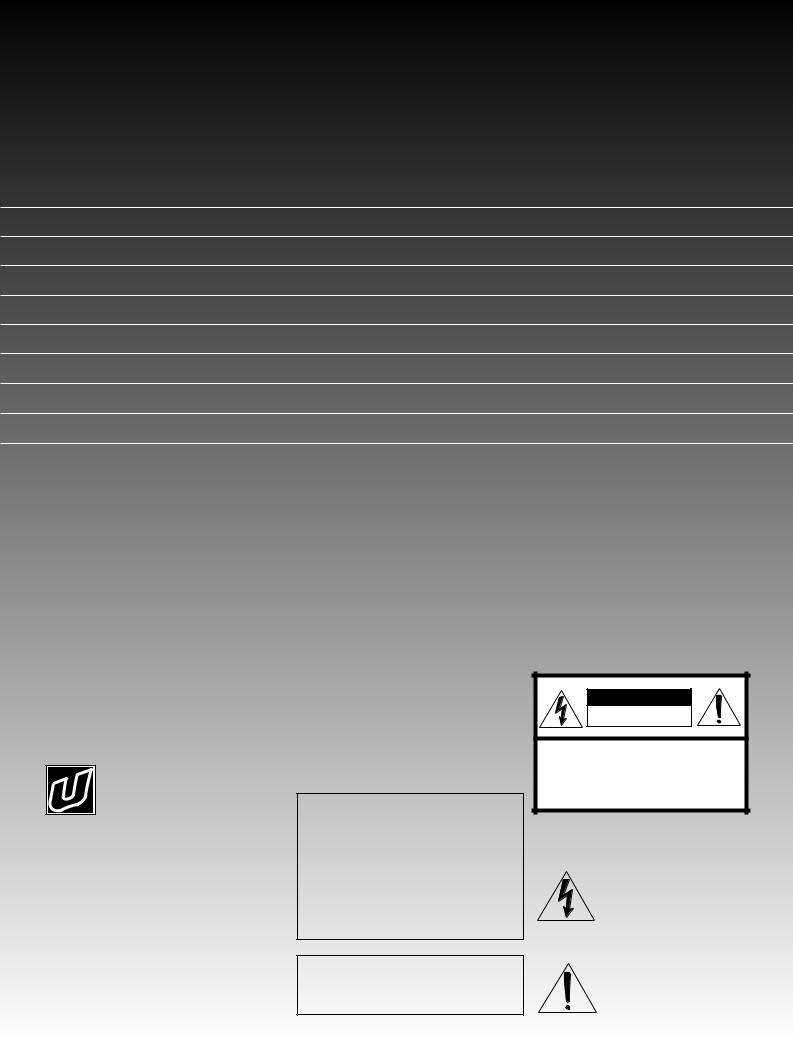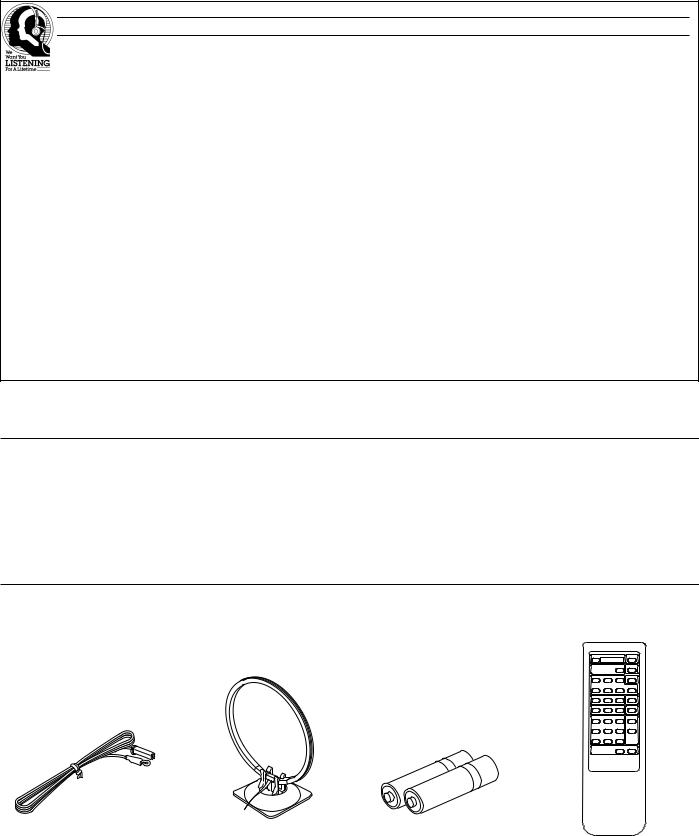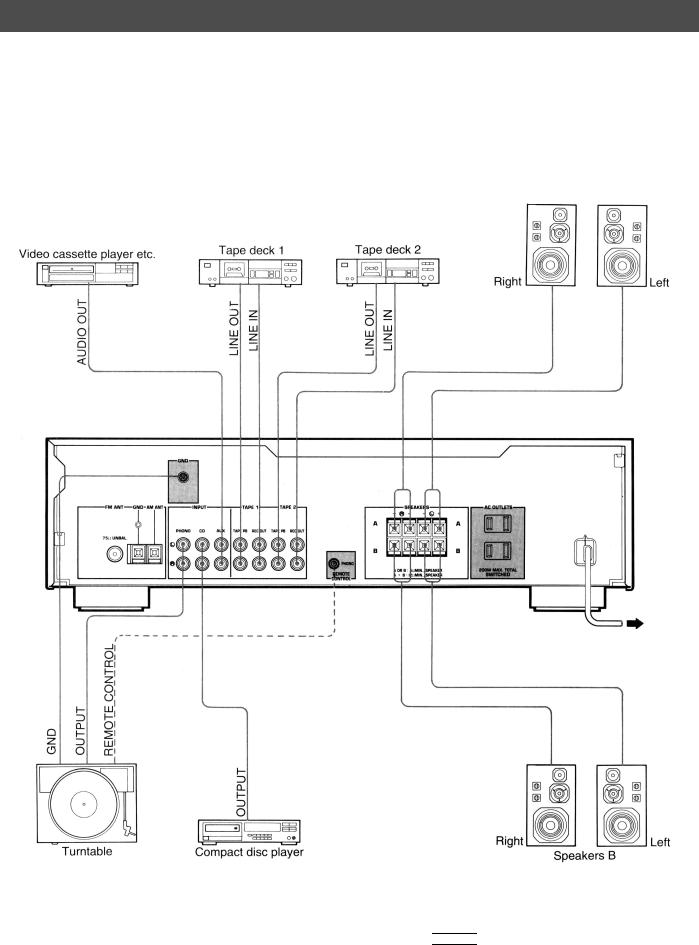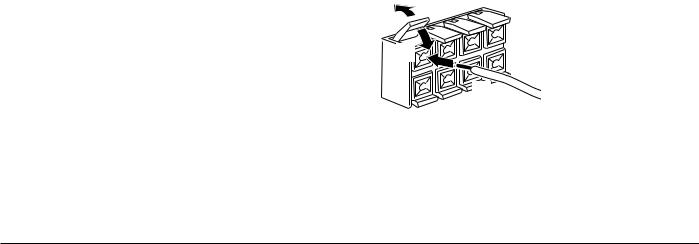Yamaha RX-460 User Manual






 RX-460
RX-460
Natural Sound Stereo Receiver
55W + 55W (8Ω ) RMS Output Power, 0.04% THD, 20 – 20,000 Hz
High Dynamic Power, Low Impedance Drive Capability
Continuously Variable Loudness Control
Source Direct Switch to Reproduce the Purest Source Sound
40-Station Random Preset Tuning
IF Count Direct PLL Synthesizer Tuning System
Remote Control Capability
Thank you for selecting this YAMAHA stereo receiver.
S
OWNER’S MANUAL |
|
CONTENTS |
|
Safety Instructions ................... |
2 |
Supplied Accessories .............. |
3 |
Connections............................. |
4 |
Operations ............................... |
7 |
Tuning Operations .................. |
10 |
Remote Control Transmitter ... |
12 |
Troubleshooting ...................... |
14 |
Specifications ......................... |
15 |
IMPORTANT!
Please record the serial number of this unit in the space below.
Model:
Serial No.:
The serial number is located on the rear of the unit.
Retain this Owner’s Manual in a safe
place for future reference.
WARNING
TO REDUCE THE RISK OF FIRE OR
ELECTRIC SHOCK, DO NOT EXPOSE
THIS UNIT TO RAIN OR MOISTURE.
CAUTION
RISK OF ELECTRIC SHOCK
DO NOT OPEN
CAUTION: TO REDUCE THE RISK OF
ELECTRIC SHOCK, DO NOT REMOVE
COVER (OR BACK), NO USER-SERVICEABLE PARTS INSIDE, REFER SERVICING TO QUALIFIED SERVICE PERSONNEL.
• Explanation of Graphical Symbols
The lightning flash with arrowhead symbol, within an equilateral triangle,
is intended to alert you to the presence of uninsulated “dangerous voltage” within the product’s enclosure that may be of sufficient
magnitude to constitute a risk of
electric shock to persons.
The exclamation point within an equilateral triangle is intended to alert
you to the presence of important operating and maintenance (servicing) instructions in the
literature accompanying the
appliance.

SAFETY INSTRUCTIONS
1Read Instructions – All the safety and operating instructions should be read before the unit is operated.
2Retain Instructions – The safety and operating instructions should be retained for future reference.
3Heed Warnings – All warnings on the unit and in the operating instructions should be adhered to.
4Follow Instructions – All operating and other instructions should be followed.
5Water and Moisture – The unit should not be used near water – for example, near a bathtub, washbowl, kitchen sink, laundry tub, in a wet basement, or near a swimming pool, etc.
6Carts and Stands – The unit should be used only with a cart or stand that is recommended by the manufacturer.
6A A unit and cart combination should be moved with care. Quick stops, excessive force, and uneven surfaces may cause the unit and cart combination to overturn.
7Wall or Ceiling Mounting – The unit
should be mounted to a wall or ceiling only as recommended by the manufacturer.
8Ventilation – The unit should be situated so that its location or position does not interfere with its proper ventilation. For example, the unit should not be situated on a bed, sofa, rug, or similar surface, that may block the ventilation openings; or placed in a built-in installation, such as a bookcase or cabinet that may impede the flow of air through the ventilation openings.
9Heat – The unit should be situated away from heat sources such as radiators, stoves, or other appliances that produce heat.
10Power Sources – The unit should be connected to a power supply only of the type described in the operating instructions or as marked on the unit.
11Power-Cord Protection – Power-supply cords should be routed so that they are not likely to be walked on or pinched by items placed upon or against them, paying particular attention to cords at plugs, convenience receptacles, and the point where they exit from the unit.
12Cleaning – The unit should be cleaned only as recommended by the manufacturer.
13Nonuse Periods – The power cord of the unit should be unplugged from the outlet when left unused for a long period of time.
14Object and Liquid Entry – Care should be taken so that objects do not fall into and liquids are not spilled into the inside of the unit.
15Damage Requiring Service – The unit should be serviced by qualified service personnel when:
A.The power-supply cord or the plug has been damaged; or
B.Objects have fallen, or liquid has been spilled into the unit; or
C.The unit has been exposed to rain; or
D.The unit does not appear to operate normally or exhibits a marked change in performance; or
E.The unit has been dropped, or the cabinet damaged.
16Servicing – The user should not attempt to service the unit beyond those means described in the operating instructions. All other servicing should be referred to qualified service personnel.
17Power Lines – An outdoor antenna should be located away from power lines.
18Grounding or Polarization – Precautions should be taken so that the grounding or polarization is not defeated.
19Outdoor Antenna Grounding – If an outside antenna is connected to this unit, be sure the antenna system is grounded so as to provide some protection against voltage surges and built-up static charges. Article 810 of the National Electrical Code, ANSI/NFPA 70, provides information with regard to proper grounding of the mast and supporting structure, grounding of the lead-in wire to an antenna discharge unit, size of grounding conductors, location of antenna discharge unit, connection to grounding electrodes, and requirements for the grounding electrode.
EXAMPLE OF ANTENNA GROUNDING
MAST |
ANTENNA |
|
LEAD IN |
|
WIRE |
GROUND |
|
CLAMP |
|
|
ANTENNA |
|
DISCHARGE UNIT |
|
(NEC SECTION 810–20) |
ELECTRIC |
|
SERVICE |
|
EQUIPMENT |
GROUNDING CONDUCTORS |
|
|
|
(NEC SECTION 810–21) |
|
GROUND CLAMPS |
|
POWER SERVICE GROUNDING |
|
ELECTRODE SYSTEM |
|
(NEC ART 250. PART H) |
NEC – NATIONAL ELECTRICAL CODE |
|
Note to CATV system installer:
This reminder is provided to call the CATV system installer's attention to Article 820-40 of the NEC that provides guidelines for proper grounding and, in particular, specifies that the cable ground shall be
connected to the grounding system of the building, as close to the point of cable entry as practical.
CAUTION: READ THIS BEFORE OPERATING YOUR UNIT
1To ensure the finest performance, please read this manual carefully. Keep it in a safe place for future reference.
2Install your unit in a cool, dry, clean place – away from windows, heat sources, and too much vibration, dust, moisture or cold. Avoid sources of hum (transformers, motors). To prevent fire or electrical shock, do not expose to rain and water.
3Do not operate the unit upside-down. It may overheat, possibly causing damage.
4Never open the cabinet. If a foreign object drops into the set, contact your dealer.
5Do not use force on switches, knobs or cords. When moving the set, first turn the unit off. Then gently disconnect the power plug and the cords connecting to other equipment. Never pull the cord itself.
6Do not attempt to clean the unit with chemical solvents; this might damage the finish. Use a clean, dry cloth.
2

7Always set the volume control to “–∞ ” before starting the audio source play: increase the volume gradually to an appropriate level after the play is started.
8To prevent lightning damage, pull out the power cord and remove the antenna cable during an electrical storm.
9Be sure to read the “Troubleshooting” section on common operating errors before concluding that your unit is faulty.
10Do not connect audio equipment to the AC outlets on the rear panel if that equipment requires more power than the outlets are rated to provide.
FCC INFORMATION
1. IMPORTANT NOTICE : DO NOT MODIFY THIS UNIT! |
Compliance with FCC regulations does not guarantee that |
|
This product, when installed as indicated in the |
interference will not occur in all installations. If this product |
|
instructions contained in this manual, meets FCC |
is found to be the source of interference, which can be |
|
requirements. Modifications not expressly approved by |
determined by turning the unit “OFF” and “ON”, please try |
|
Yamaha may void your authority, granted by the FCC, to |
to eliminate the problem by using one of the following |
|
use the product. |
measures: |
|
2. IMPORTANT : When connecting this product to |
Relocate either this product or the device that is being |
|
accessories and/or another product use only high quality |
affected by the interference. |
|
shielded cables. Cable/s supplied with this product |
Utilize power outlets that are on different branch (circuit |
|
MUST be used. Follow all installation instructions. |
||
breaker or fuse) circuits or install AC line filter/s. |
||
Failure to follow instructions could void your FCC |
||
|
||
authorization to use this product in the USA. |
In the case of radio or TV interference, relocate/reorient the |
|
3. NOTE : This product has been tested and found to |
antenna. If the antenna lead-in is 300 ohm ribbon lead, |
|
comply with the requirements listed in FCC Regulations, |
change the lead-in to coaxial type cable. |
|
Part 15 for Class “B” digital devices. Compliance with |
If these corrective measures do not produce satisfactory |
|
these requirements provides a reasonable level of |
||
results, please contact the local retailer authorized to |
||
assurance that your use of this product in a residential |
||
distribute this type of product. If you can not locate the |
||
environment will not result in harmful interference with |
||
appropriate retailer, please contact Yamaha Electronics |
||
other electronic devices. |
||
Corp., U.S.A. 6660 Orangethorpe Ave, Buena Park, CA |
||
This equipment generates/uses radio frequencies and, if |
||
90620. |
||
not installed and used according to the instructions |
The above statements apply ONLY to those products |
|
found in the users manual, may cause interference |
||
distributed by Yamaha Corporation of America or its |
||
harmful to the operation of other electronic devices. |
||
subsidiaries. |
||
|
We Want You Listening For A Lifetime
YAMAHA and the Electronic Industries Association’s Consumer Electronics Group want you to get the most out of your equipment by playing it at a safe level. One that lets the sound come through loud and clear without annoying blaring or distortion – and, most importantly, without affecting your sensitive hearing. Since hearing damage from loud sounds is
often undetectable until it is too late, YAMAHA and the Electronic Industries Association’s Consumer Electronics Group recommend you to avoid prolonged exposure from excessive volume levels.
SUPPLIED ACCESSORIES
After unpacking, check that the following parts are contained.
Indoor FM Antenna |
AM Loop Antenna |
Batteries (size AA, R6, UM-3) |
Remote Control Transmitter |
3

CONNECTIONS
Before attempting to make any connections to or from this unit, be sure to first switch OFF the power to this unit and to any other components to which connections are being made.
AUDIO CONNECTIONS
When making connections between this unit and other components, be sure all connections are made correctly, that is to say L
(left) to L, R (right) to R, “+” to “+” and “–” to “–”. Also, refer to the owner’s manual for each component to be connected to this unit.
Speakers A
Video cassette player etc. |
|
Tape deck 1 |
Tape deck 2 |
|
|
|
|
Right |
|
Left |
(U.S.A. model)
To AC model
|
|
|
|
Right |
|
|
|
Left |
Turntable |
|
Compact disc player |
|
|
|
|
|
|
Speakers B |
|
|
||||||
|
|
|
|
|
|
|||
|
|
|
|
|
|
|||
|
|
|
|
|
|
|
|
|
* 
 : Refer to “ABOUT THE ACCESSORY TERMINALS” on page 5.
: Refer to “ABOUT THE ACCESSORY TERMINALS” on page 5.
4

CONNECTING SPEAKERS
Connect the SPEAKERS terminals to your speakers with wire of the proper gauge, cut to be as short as possible. If the connections are faulty, no sound will be heard from the speakers. Make sure that the polarity of the speaker wires is correct, that is, + and – markings are observed. If these wires are reversed, the sound will be unnatural and will lack bass.
Do not let the bare speaker wires touch each other and do not let them touch the metal parts of this unit as this could damage this unit and/or speakers.
●One or two speaker systems can be connected to this unit. If you connect only one speaker system, connect it to either the SPEAKERS A or B terminals.
●Use speakers with the specified impedance shown on the rear of this unit.
How to Connect:
Red: positive (+)
Black: negative (–)
|
Press up the tab. |
|
the bare wire. |
||
|
||
|
[Remove approx. 5mm |
|
|
insulation from |
|
|
speaker wires.] |
|
|
Press down the tab and |
|
|
secure the wire. |
ABOUT THE ACCESSORY TERMINALS
AC OUTLETS
(U.S.A., Canada Europe and General models)
............................................................2 SWITCHED OUTLETS (Australia and U.K. models)
...............................................................1 SWITCHED OUTLET Use these to connect the power cords from your components to this unit.
The power to the SWITCHED outlets is controlled by this unit’s POWER switch or the provided remote control transmitter’s POWER key. These outlets will supply power to any component whenever this unit is turned on.
The maximum power (total power consumption of components) that can be connected to the SWITCHED AC OUTLETS is 100 watts (200 watts for U.S.A. and General models).
REMOTE CONTROL (PHONO) connector
If you have a YAMAHA turntable with the  mark, connect it to this connector by using the cable provided with the turntable. This connection allows you to control the turntable from the provided remote control transmitter.
mark, connect it to this connector by using the cable provided with the turntable. This connection allows you to control the turntable from the provided remote control transmitter.
GND terminal (For turntable use)
Connecting the ground wire of the turntable to this terminal will minimize hum, but in some cases better results may be obtained with the ground wire disconnected.
5
